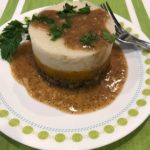Thanksgiving Stack
There are several ways to stack some favorite sides and make a beautiful presentation! This recipe is more about technique and uses Sage-Quinoa dressing, Butternut Squash baked with sage and onion, a final topping of mashed potatoes and then topped with a delicious mushroom gravy. It's an extra step but so easy!
Servings: 6 people
Ingredients
- 1 Recipe Sage-Quinoa Dressing
- 1 Recipe Butternut Squash with a maple-sage glaze
- 1 Recipe Mashed Potatoes
- 1 Recipe Mushroom Gravy
Instructions
- These sides can be stacked two ways. The first method is to layer everything one layer at a time in a loaf pan that will be inverted onto the final serving plate. I used a sushi mold press to get the layers compressed and smooth but anything with a smooth, plate squared surface will work.
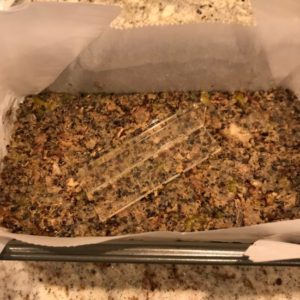
- The second method is to prepare all recipes then form the stacks using a ring mod in the final preparation before serving.
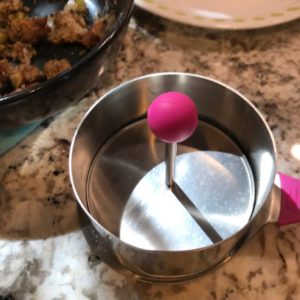
- Method 1:
- I built my layers with the dressing on the bottom and mashed potatoes were last. This was a mistake because the loaf pan is wider at the top and I could not keep the pan in the oven to stay warm without drying out the potatoes.
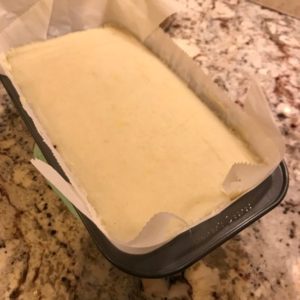
- Because I made this with potatoes as the last layer, I had to invert it out of the pan and flip again to to have the potatoes side up on the plate.
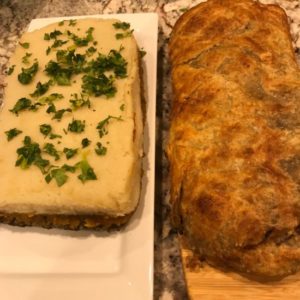
- Put a layer of parchment paper in the bottom of your loaf pan. You may need to cut it to get the paper to come up evenly around the sides.
- Start with a layer of mashed potatoes and smooth with a spatula or a sushi press. Press down to make sure there are no gaps or holes.
- Next layer the butternut squash. Gently repeat the pressing and smoothing process.
- Last layer carefully distribute the sage-quinoa dressing as evenly as possible then press. The more even and compressed it is, the better your layers will come out.
- When ready to serve, put the serving platter on top of the loaf pan and flip your stacked layers onto the platter. Carefully remove the parchment paper and finish with a little chopped parsley. Serve gravy on the side.

- Method Two:
- As all recipes are prepared, this technique will simply spoon each layer into the ring mold and use the press to compress and smooth the layers. Start with the dressing for the bottom layer as the mold will be slid onto the plates and not flipped. Form this directly onto the plate or assemble with the transfer plate under the bottom of the mold so you can pick it up and slide it on a plate.
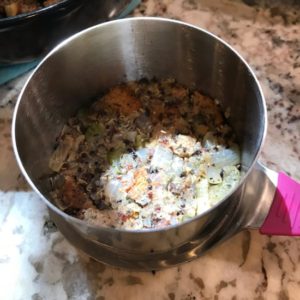
- Add the second layer (butternut squash). Press down gently with the mold press.

- All the final layer and use the press to press down gently. The final layer should completely fill the ring mold to the top.
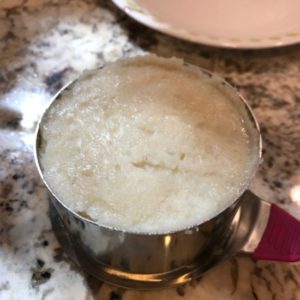
- Position over the plate and set down while simultaneously removing the transfer plate (Unless assembled directly on the plate).Use the press to push the layers out of the mold onto the plate.
- Top with a drizzle of gravy and some fresh parsley.
Notes
 This technique by Snap Pea Sheep
This technique can be used with any sides. Make sure the heaviest is at the bottom. Any layer should be fairly stiff to prevent the stack from sliding into a puddle.
The final molded product can be made higher than the mold by simply sliding the mold up and filling it as you go.
I purchased the Ateco, Round Food Molding set that includes two stainless steel rings (3.5" X 2.125"), the fitted press and transfer plate on Amazon. This size is typically used for entrée portions.
The rings are dishwasher safe. They are heavy enough you could maybe bake with them then use a wide spatula to move them from the baking sheet.
This technique by Snap Pea Sheep
This technique can be used with any sides. Make sure the heaviest is at the bottom. Any layer should be fairly stiff to prevent the stack from sliding into a puddle.
The final molded product can be made higher than the mold by simply sliding the mold up and filling it as you go.
I purchased the Ateco, Round Food Molding set that includes two stainless steel rings (3.5" X 2.125"), the fitted press and transfer plate on Amazon. This size is typically used for entrée portions.
The rings are dishwasher safe. They are heavy enough you could maybe bake with them then use a wide spatula to move them from the baking sheet.